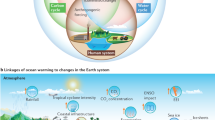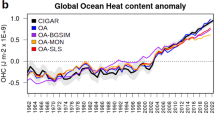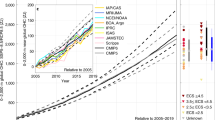Abstract
The ocean takes up about 93% of the global warming heat entering Earth’s climate system. In addition, the associated thermal expansion contributes substantially to sea-level rise. Hence, quantifying the oceanic heat uptake rate and its statistical significance has been a research focus. Here we use gridded ocean heat content maps to examine regional trends in ocean warming for 0–700 m depth from 1993–2019 and 1968–2019, periods based on sampling distributions. The maps are from four research groups, three based on ocean temperature alone and one combining ocean temperature with satellite altimeter sea-level anomalies. We show that use of longer periods results in larger percentages of ocean area with statistically significant warming trends and less ocean area covered by statistically significant cooling trends. We discuss relations of these patterns to climate phenomena, including the Pacific Decadal Oscillation, the Atlantic Meridional Overturning Circulation and global warming.
This is a preview of subscription content, access via your institution
Access options
Access Nature and 54 other Nature Portfolio journals
Get Nature+, our best-value online-access subscription
$29.99 / 30 days
cancel any time
Subscribe to this journal
Receive 12 print issues and online access
$209.00 per year
only $17.42 per issue
Buy this article
- Purchase on Springer Link
- Instant access to full article PDF
Prices may be subject to local taxes which are calculated during checkout



Similar content being viewed by others
Data availability
The Ssalto/Duacs global maps of satellite-altimeter-derived sea-surface height anomalies used for the PMEL maps were downloaded in January 2019 and can be accessed at https://www.aviso.altimetry.fr/en/data/products/sea-surface-height-products/global.html. The in situ Argo data used for the PMEL maps (https://doi.org/10.17882/42182#61117) were downloaded from the US Argo Global Data Assembly Center in January 2019 and can be accessed at https://www.usgodae.org//argo/argo.html. The historical in situ temperature data other than Argo used for the PMEL maps were EN3 v2a from www.metoffice.gov.uk/hadobs. This version has been superseded, but historical non-Argo data in later versions are very similar. The ocean heat content maps from JMA can be accessed at https://www.data.jma.go.jp/gmd/kaiyou/english/ohc/ohc_global_en.html, those from IAP at http://159.226.119.60/cheng/ and those from NCEI at https://www.nodc.noaa.gov/OC5/3M_HEAT_CONTENT/.
References
IPCC Climate Change 2013: The Physical Science Basis (eds Stocker, T. F. et al.) (Cambridge Univ. Press, 2013).
Cazenave, A. et al. Global sea-level budget 1993–present. Earth Syst. Sci. Data 10, 1551–1590 (2018).
Meyssignac, B. et al. Measuring global ocean heat content to estimate the Earth energy imbalance. Front. Mar. Sci. 6, 432 (2019).
Johnson, G. C., Lyman, J. M. & Loeb, N. G. Improving estimates of Earth’s energy imbalance. Nat. Clim. Change 6, 639–640 (2016).
Roemmich, D. et al. Unabated planetary warming and its ocean structure since 2006. Nat. Clim. Change 5, 240–245 (2015).
Wijffels, S., Roemmich, D., Monselesan, D., Church, J. & Gilson, J. Ocean temperatures chronicle the ongoing warming of Earth. Nat. Clim. Change 6, 116–118 (2016).
Abraham, J. P. et al. A review of global ocean temperature observations: implications for ocean heat content estimates and climate change. Rev. Geophys. 51, 450–483 (2013).
Lyman, J. M. & Johnson, G. C. Estimating global ocean heat content changes in the upper 1800 m since 1950 and the influence of climatology choice. J. Clim. 27, 1945–1957 (2014).
Roemmich, D. et al. On the future of Argo: a global, full-depth, multi-disciplinary array. Front. Mar. Sci. 6, 439 (2019).
Johnson, G. C. & Birnbaum, A. N. As El Niño builds, Pacific Warm Pool expands, ocean gains more heat. Geophys. Res. Lett. 44, 438–445 (2017).
Roemmich, D. & Gilson, J. The global ocean imprint of ENSO. Geophys. Res. Lett. 38, L13606 (2011).
Palanisamy, H., Meyssignac, B., Cazenave, A. & Delcroix, T. Is anthropogenic sea level fingerprint already detectable in the Pacific Ocean? Environ. Res. Lett. 10, 084024 (2015).
Wills, R. C. J. et al. Ocean circulation signatures of North Pacific decadal variability. Geophys. Res. Lett. 46, 1690–1701 (2019).
Kenigson, J. S., Han, W. Q., Rajagopalan, B., Yanto & Jasinsk, M. Decadal shift of NAO-linked interannual sea level variability along the US northeast coast. J. Clim. 31, 4981–4989 (2018).
Roemmich, D., Gilson, J., Sutton, P. & Zilberman, N. Multidecadal change of the South Pacific Gyre circulation. J. Phys. Oceanogr. 46, 1871–1883 (2016).
Carson, M. & Harrison, D. E. Regional interdecadal variability in bias-corrected ocean temperature data. J. Clim. 23, 2847–2855 (2010).
Richter, K. & Marzeion, B. Earliest local emergence of forced dynamic and steric sea-level trends in climate models. Environ. Res. Lett. 9, 114009 (2014).
Blunden, J. & Arndt, D. S. State of the climate in 2018. Bull. Am. Meteorol. Soc. 100, Si–S305 (2019).
Johnson, G. C. et al. in State of the Climate in 2019 (Ed. Lumpkin, R.) S74–S77 (American Meteorological Society, 2019).
Ishii, M. et al. Accuracy of global upper ocean heat content estimation expected from present observational data sets. Sola 13, 163–167 (2017).
Cheng, L. J. et al. Improved estimates of ocean heat content from 1960 to 2015. Sci. Adv. 3, e1601545 (2017).
Levitus, S. et al. World ocean heat content and thermosteric sea level change (0-2000 m), 1955-2010. Geophys. Res. Lett. 39, L10603 (2012).
Wu, L. X. et al. Enhanced warming over the global subtropical western boundary currents. Nat. Clim. Change 2, 161–166 (2012).
McCarthy, G. D., Joyce, T. M. & Josey, S. A. Gulf Stream variability in the context of quasi-decadal and multidecadal Atlantic climate variability. Geophys. Res. Lett. 45, 11257–11264 (2018).
Wang, Y. L. & Wu, C. R. Discordant multi-decadal trend in the intensity of the Kuroshio along its path during 1993-2013. Sci. Rep. 8, 14633 (2018).
Chen, X. Y. & Tung, K. K. Varying planetary heat sink led to global-warming slowdown and acceleration. Science 345, 897–903 (2014).
Liu, W., Xie, S. P. & Lu, J. Tracking ocean heat uptake during the surface warming hiatus. Nat. Commun. 7, 10926 (2016).
He, C. F., Liu, Z. Y. & Hu, A. X. The transient response of atmospheric and oceanic heat transports to anthropogenic warming. Nat. Clim. Change 9, 222–226 (2019).
Armour, K. C., Marshall, J., Scott, J. R., Donohoe, A. & Newsom, E. R. Southern Ocean warming delayed by circumpolar upwelling and equatorward transport. Nat. Geosci. 9, 549 (2016).
Mantua, N. J., Hare, S. R., Zhang, Y., Wallace, J. M. & Francis, R. C. A Pacific interdecadal climate oscillation with impacts on salmon production. Bull. Am. Meteorol. Soc. 78, 1069–1079 (1997).
Salinger, M. J., Renwick, J. A. & Mullan, A. B. Interdecadal Pacific Oscillation and South Pacific climate. Int. J. Climatol. 21, 1705–1721 (2001).
Merrifield, M. A. & Maltrud, M. E. Regional sea level trends due to a Pacific trade wind intensification. Geophys. Res. Lett. 38, L21605 (2011).
Hamlington, B. D. et al. An ongoing shift in Pacific Ocean sea level. J. Geophys. Res. Oceans 121, 5084–5097 (2016).
Roxy, M. K., Ritika, K., Terray, P. & Masson, S. The curious case of Indian Ocean warming. J. Clim. 27, 8501–8509 (2014).
Caesar, L., Rahmstorf, S., Robinson, A., Feulner, G. & Saba, V. Observed fingerprint of a weakening Atlantic Ocean overturning circulation. Nature 556, 191 (2018).
Smeed, D. A. et al. The North Atlantic Ocean Is in a state of reduced overturning. Geophys. Res. Lett. 45, 1527–1533 (2018).
Josey, S. A. et al. The recent Atlantic cold anomaly: causes, consequences, and related phenomena. Annu. Rev. Mar. Sci. 10, 475–501 (2018).
Durack, P. J. et al. Quantifying underestimates of long-term upper-ocean warming. Nat. Clim. Change 4, 999–1005 (2014).
Durack, P. J. et al. Ocean warming: from the surface to the deep in observations and models. Oceanography 31, 41–51 (2018).
Ingleby, B. & Huddleston, M. Quality control of ocean temperature and salinity profiles—historical and real-time data. J. Mar. Syst. 65, 158–175 (2007).
Locarnini, R. A. et al. World Ocean Atlas 2009, Volume 1: Temperature (US Government Printing Office, 2010).
Ishii, M. & Kimoto, M. Reevaluation of historical ocean heat content variations with time-varying XBT and MBT depth bias corrections. J. Oceanogr. 65, 287–299 (2009).
Smith, W. H. F. & Sandwell, D. T. Global sea floor topography from satellite altimetry and ship depth soundings. Science 277, 1956–1962 (1997).
Wunsch, C. The Ocean Circulation Inverse Problem (Cambridge Univ. Press, 1996).
von Storch, H. & Zwiers, F. W. Statistical Analysis in Climate Research (Cambridge Univ. Press, 1999).
Acknowledgements
G.C.J. and J.M.L. are supported by the Global Ocean Monitoring and Observing programme, National Oceanic and Atmospheric Administration (NOAA), US Department of Commerce and NOAA Research. The Argo data used here were collected and made freely available by the International Argo Program and the national programmes that contribute to it (http://www.argo.ucsd.edu, http://argo.jcommops.org). The Argo Program is part of the Global Ocean Observing System. The Ssalto/Duacs altimeter products were produced and distributed by the Copernicus Marine and Environment Monitoring Service (CMEMS) (http://www.marine.copernicus.eu). We thank chief editor B. Wake for helpful comments and suggestions. The scientific results and conclusions, as well as any views or opinions expressed herein, are those of the authors and do not necessarily reflect the views of NOAA or the Department of Commerce. PMEL Contribution number 4968.
Author information
Authors and Affiliations
Contributions
G.C.J and J.M.L designed the study. J.M.L. made the calculations and analysed the trends. G.C.J. wrote the manuscript. Both authors contributed to interpreting the results and improving the manuscript.
Corresponding author
Ethics declarations
Competing interests
The authors declare no competing interests.
Additional information
Peer review information Nature Climate Change thanks Karina von Schuckmann and the other, anonymous, reviewer(s) for their contribution to the peer review of this work.
Publisher’s note Springer Nature remains neutral with regard to jurisdictional claims in published maps and institutional affiliations.
Extended data
Extended Data Fig. 1 Maps of means, standard deviations, and ratios of their magnitudes for the different 0–700 m ocean heat content trend estimates used.
Means of trends for (a) 1993–2019 are contoured over twice the range used for (b) 1968–2019. Similarly, the standard deviations for (c) 1993–2019 trends are contoured over twice the range used for (d) 1968–2019. The ratio of the mean trend magnitudes to their standard deviations are contoured on the same scale for (e) 1993–2019 and (f) 1968–2019. Latitudes are gridded at 30° intervals, and longitudes, centered on 150 °W, at 60° intervals (dotted lines).
Rights and permissions
About this article
Cite this article
Johnson, G.C., Lyman, J.M. Warming trends increasingly dominate global ocean. Nat. Clim. Chang. 10, 757–761 (2020). https://doi.org/10.1038/s41558-020-0822-0
Received:
Accepted:
Published:
Issue Date:
DOI: https://doi.org/10.1038/s41558-020-0822-0
This article is cited by
-
Acceleration of the ocean warming from 1961 to 2022 unveiled by large-ensemble reanalyses
Nature Communications (2024)
-
CMIP6 model evaluation for sea surface height responses to ENSO
Climate Dynamics (2024)
-
Sea level anomalies affect the ocean circulation at abyssal depths
Scientific Reports (2023)
-
Global trends of fronts and chlorophyll in a warming ocean
Communications Earth & Environment (2023)
-
Vertical structures of marine heatwaves
Nature Communications (2023)



